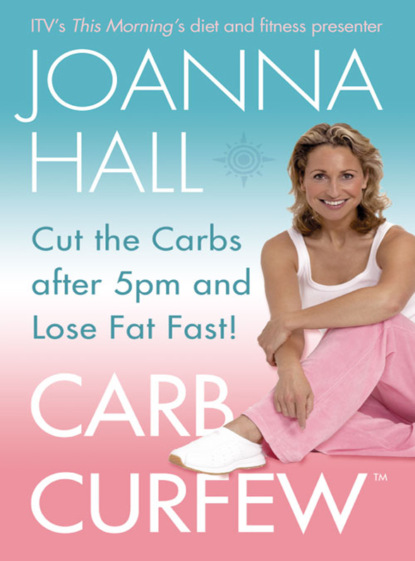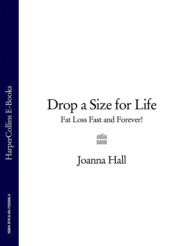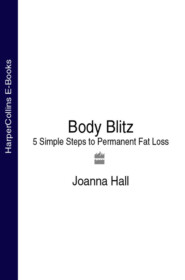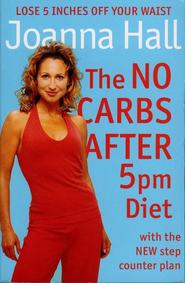По всем вопросам обращайтесь на: info@litportal.ru
(©) 2003-2024.
✖
Carb Curfew: Cut the Carbs after 5pm and Lose Fat Fast!
Автор
Год написания книги
2018
Настройки чтения
Размер шрифта
Высота строк
Поля
The most effective way to decrease the size of your fat cells is to reduce your weekly intake of calories. Obviously this can be achieved through diet alone, but it is far more effective—and easier—to use a combination of sensible nutrition and physical activity. For fat cells to get smaller we need to create a calorie deficit of 3,500 calories per week. At first sight this figure can appear alarming, however the trick to effective body fat loss is to ensure that the calorie deficit is achieved slowly and consistently. Spreading the 3,500 over seven days means you are aiming for a decrease of 500 calories each day from your normal daily calorie range. If you split these 500 calories between the nutritional strategies in Carb Curfew and physical activities, the figure becomes a lot more manageable. Incorporating exercise into your routine (whether this involves walking instead of taking the car or fitting in regular sessions at the gym) will go a long way towards helping you achieve your goal.
Ways to Save 500 Calories a Day
Everyday physical activity: Walk to the post office rather than drive, take the stairs at work, walk up the escalators. Saves you 100 calories.
Exercise: Power walk for one mile. Saves you 100 calories.
Nutrition: Operate Carb Curfew in evening meal. Replace a portion of pasta with two portions of extra vegetables. Saves you 200 calories. Replace mid-afternoon snack of 2 slices of bread and jam with an apple. Saves you 100 calories.
Why Do We Gain Weight Faster As We Get Older?
As we get older we actually start to lay down more body fat. This is due to several factors:
1. Metabolic rate
After the age of 30 if we are inactive we actually start to lose muscle mass at a rate of 1/3–½ pound every two years. So if you weighed 10 stone at the age of 20 and you still weigh 10 stone at the age of 50, yet you have gone up two clothes sizes and you do not exercise – quite simply, you have lost muscle mass and gained body fat. As the body fat takes up more space, your clothes become tighter and your clothes size goes up. Muscle is metabolically active, which means that it burns calories. So if we start to lose muscle mass we actually require less calories to do our everyday tasks. Long-term this means we can potentially be consuming the same number of calories at the age of 20 as at the age of 50 but when we are 50 these calories are not burnt off and we are more prone to laying down body fat. This puts our health at risk and we become frustrated with our shape.
2. Hormones
As women start to approach the menopause we enter a stage known as peri menopause – at this time there is a change in our hormones, which may actually encourage our bodies to lay down more body fat.
3. Stress
Yes, stress does make us fat! When we are experiencing long periods of chronic stress such as overwork, or emotional stresses such as a loss of a partner or moving home, there is a change in our metabolism that encourages increased secretion of the hormone Cortisol. If this is left unchecked for long periods of time it encourages body fat to be laid down around our midriffs. Research has shown that storing body fat here actually puts us at a greater risk of heart disease.
Whilst this all may seem a little depressing, the best possible course of action you can take is also the most accessible and cheapest – get active! Increasing your level of physical activity has both a positive and immediate impact on your health and ability to control your weight.
Why Do Some People Lose Body Fat Faster Than Others?
Not everyone will lose weight and body fat at the same rate. We are all different, and there are several factors that can affect our rate of weight and body fat loss.
These include:
1. Your existing metabolic rate
2. Your dieting history
3. Your exercise history
4. Your existing eating patterns
5. Your existing activity patterns
1. Your Existing Metabolic Rate
As we have just discussed, our muscle mass starts to decrease as we get older and our metabolic rate tends to slow down, which means we burn fewer calories. Imagine you are 20 years old and you are sitting in a chair, and now imagine you are 50 years old sitting in a chair. Even though you are doing exactly the same everyday activity, if you have not kept up your muscle mass between the ages of 20 and 50 you will be burning less calories sitting still at the age of 50 than sitting still at the age of 20.
2. Your Dieting History
If you are a seasoned dieter and you religiously try every diet on the market and have experienced weight gain/weight loss again and again – long-term it will be harder to lose weight effectively. You may already have experienced this. For example, every January you may have a favourite deprivation diet that gives you great results – well, it did the first couple of times you did it and now you are experiencing frustration as the scales are not giving you the results you want. This is because as the body is continually put through phases of excess and deficit there comes a time when our metabolism may stop working effectively and instead of losing weight we can actually increase the amount of body fat we have. To counteract this you need to stabilize you calorie and fat intake now. Chapter six will show you how to be consistent with your nutrient intake.
3. Your Exercise History
To lose weight and body fat you need to exercise regularly. If you were active when you were younger you will be at an advantage as muscles have a memory—this means that even if you are not exercising now the muscles will be able to respond more effectively and quickly to exercise once you do start. But even if you were not active when you were younger, it is never too late to start. Becoming active now and staying active will help you realize your fat loss goals as well as have an immediate protective effect on your health.
4. Your Existing Eating Patterns
Quite simply, the more erratic our eating patterns the harder it is to lose weight, and the longer you have had erratic eating patterns the more frustration you are likely to experience trying to lose weight. The body actually balances itself out over seven to eight days; however, in those seven to eight days if you have overeaten one day and then starved yourself the next in an attempt to make up for the excesses, the body will rebel and you will not lose weight and body fat.
To lose body fat, and for us to actually see a difference in the shape of our bodies, we need to eat a healthy and balanced diet and be consistent about it. Start now – apply the Carb Curfew, cut your intake of fat and be consistent.
5. Your Existing Activity Patterns
If you are reading this and are frustrated because you already exercise – or consider yourself to have a pretty active daily routine – and are still not losing weight, this may be a result of the following:
You do not have enough variety in your exercise programme and your body has become complacent at always doing the same thing.
The activities that are part of your daily routine are not putting your body under enough physiological strain to increase your fitness.
If you are reading this thinking it’s about time I became more active – then what are you waiting for?
Where Do We Store Our Body Fat?
Have you ever wondered why some of us seem to store all our body fat on our hips and thighs and some of us tend to have long lean arms and legs but store more of our body fat around our midriffs? This distribution of fat is associated directly to two main hormones in the body. These hormones, lipoprotein lipase LPL and hormone sensitive lipase HSL, directly affect whether we store fat or encourage it to be distributed in the blood and then burnt off LPL tends to encourage fat storage and HSL tends to encourage fat to be burnt off The amount of LPL and HSL we have tends to vary between men and women, individuals and areas of the body.
Men tend to have more LPL in the belly and less HSL in the lower hip area. This creates the more pronounced apple shape we see in overweight men, with more body fat distributed around the belly. Women tend to have more LPL in the hips and back of the arms and less HSL in the upper body. This classically creates more of our traditional pear shape. When women lose weight we generally still have more LPL in the hips so still have a pear shape.
So the challenge for us is to try and create more HSL and one of the best ways to do this is with exercise. Weight-bearing aerobic exercise such as brisk walking, jogging and aerobics is the best form of exercise to choose. Swimming, even though it is an aerobic activity, has shown to be less effective for weight loss as it is non-weight bearing so it is not so effective in burning off calories. In addition, swimming increases LPL, which has the effect of decreasing our core temperature, which in turn can stimulate us to eat more.
Carb Curfew will help you reduce your weight and body fat and boost your confidence to put you in control long-term. It is important to understand however that due to your own individual makeup your body will have an optimum shape it naturally wants to be.
Why Is Measuring Body Fat Important?
When we stand on weighing scales we are actually measuring our total body weight, which is made up of muscle tissue (also known as muscle mass or fat-free mass) and fat tissue (also known as fat mass). Muscle is denser than body fat, so if you took a pound of muscle and you took a pound of fat, the pound of fat would take up a lot more space. It is the amount of fat that we have in our bodies that actually affects our body shape and health. The reading we receive from traditional bathroom scales tells us what the total amount of our body weight is – body fat and muscle (and other tissue such as bone) – but it does not tell us how much fat we actually have. It is this excess body fat that is associated with heart disease, high blood pressure, diabetes and certain types of cancer. By measuring our body fat not only are we monitoring how much of our weight is actually fat but it also gives us an indicator of our health status. Monitoring our percentage body fat actually allows us to impact our health by ensuring we lose body fat as opposed to muscle mass.
Studies have shown that with very low calorie diets, the body will actually lose muscle mass and keep hold of body fat. This means that with some ‘diets’ you may actually increase the amount of body fat you have!
How Can I Measure How Much Body Fat I Have?
Body fat can be measured in a number of ways. One method is with skin-fold calipers. The skin folds are generally taken at four sites around the body.
A more convenient and accurate method to measure in your own home however is with body fat monitors. Constructed as a set of bathroom weighing scales, by entering your height and sex and standing on the scales, a safe technique known as bioelectrical impedance analysis will determine your percentage body fat. Replacing bathroom scales with body fat monitors will give a true idea of what is happening inside you – this way you get to see a complete picture of your total body weight, muscle mass and fat mass. Body fat monitors are now available from a wide range of outlets.
How Much Body Fat Should We Have?
We all need to have body fat. Too little and we run the risk of decreased fertility and the onset of amenorrhea, a condition where the female periods stop. Too much body fat is associated with an increased risk of heart disease, hypertension, diabetes and some cancers. So what exactly are the healthy ranges? The figures shown below are broadly accepted as the ideal percentages for body fat.
What Fat-Loss Target Should We Aim For?











